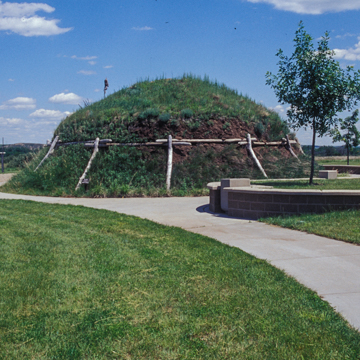This National Historic Landmark contains powerful evidence of more than seven thousand years of activity embodied in forty-four distinct archaeological sites spread over five hundred and fifty acres. The sites, which are located on the banks of the Knife River near its confluence with the Missouri River, document cultural adaptation to the rigorous Great Plains environment. Three of these sites are Hidatsa communities and they contain the best-preserved earthlodge depressions of any major Native American site on the Plains. These communities show the effects of nearly a century of fur trade interaction with Euro-Americans, including the drastic result of epidemics and material culture changes. The Mandan and Hidatsa inhabitants of these semi-permanent, earth-and-timber villages were so successful at adapting to the environment that they were able to exchange crop surpluses and trade goods with other Native American groups. Their agriculturally based villages became centers of trade, attracting both Native Americans and Euro-Americans. The villages most famous resident was the Lemhi Shosone woman Sakakawea (spelled variously in Anglo texts as Sacajawea and Sacagawea), who substantially aided Lewis and Clark on their explorations.
Archaeological evidence at this sacred site is profuse. Undistrubed sites, remnants of long-term occupation, and repeated earthlodge construction activities are covered with a thick earthen mantle up to six feet thick. Pre-contact earthlodge culture of the Three Affiliated Tribes is interpreted with accurate reconstructions and a vistitor's center (ME2). Vistors will be reminded that the power of a place is not always embodied in our rational perceptions, but in the accumulated spiritual power of a setting like this.















